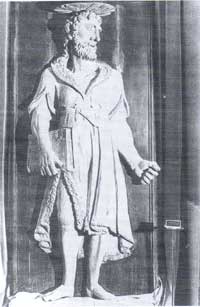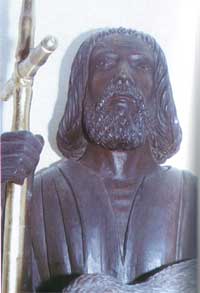It has sometimes been
mistakenly described as a figurehead but as pointed out by Paolo
Maria Paciaudi, who studied it in 1755, its flat back makes
it clear that it was fixed to a level surface such as the tower
on the stern (30).
When the caracca was laid up in 1548, the
statue was first donated to the church of St. John the Almoner,
known as Ta' Ghuxa, which stood in the countryside between the
village of Tarxien and the suburb of Bormla on the Grand Harbour
(31). Bishop Miguel Balaguer
y Camarasa saw it here in 1636 while on a pastoral visitation,
and described it as a "large and gilt sculpture"(32).
Its provenance was highlighted at a later period, in 1647, by
the Vice Chancellor of the Order, Giovanni Francesco Abela,
who described it as an "effigie ben grande di legno
... già portata per
|
|
| Ship statue of St.
John the Baptist from the Gran Carracca of Rhodes.
Stuccoed, gessoed and painted wood. Conventual church
of St. John, Valletta. Photo credit: The Cathedral
Museum, Mdina. |
|
insegna della caracca di Rodi."
(33). Around 1580, when the
building of the Cottonera Lines necessitated the demolition
of the church, the statue was removed to the conventual church
(34). In 1755 it was preserved
in a wall niche near the steps leading down to Bartellot crypt.
It was moved to its present location in 1858.
Paciaudi describes the statue as "weather
beaten" and he could still see the holes of the nails that
secured it to the ship. The dull white coat of paint in which
we now know it seems to belong to a nineteenth century restoration.
It must originally have been gilt and naturalistically painted.
The real value of the sculpture lies in its historical associations
rather than in any intrinsic artistic interest. It is larger
than life and the heavy, fleshy form, the position of the feet,
and the
|
|
| Statue of St. John
the Baptis with armorial graffiti. Detail. Varnished
wood with traces of polychromy. The reed cross is a recent
accretion. Parish Church of the Assumption of the Virgin,
Dingli. Photo Credit: Dr Mario Buhagiar |
|
|
[30] P.M.
Paciaudi, De Cultu Sancti Johannis Baptistae, Rome 1755, 315-316.
[31] The exact location of the church is unknown but there
are indications that it stood in present day Fgura, just outside the
Margherita Lines in the neighbourhood of St. Thomas Gate: E.B. Vella,
Storja ta' Hal Tarxien u Rahal Gdid, Malta 1932, 93-96.
[32] Archiepiscopal Archives, Floriana, Visitatio Balaguer
1636, f. 36rv.
[33] G.F. Abela, Della Descrittione di Malta, Malta 1647, 105.
Abela was apparently responsible for the myth that the statue was
a figurehead.
[34] The old church of St. John the Almoner was demolished
about this time because of the building of the Cottonera Lines. A
new church was built in a new location, within the fortifications,
by the Prior Fra Pierre Vianny, but the statue remained in the conventual
church. |
|

